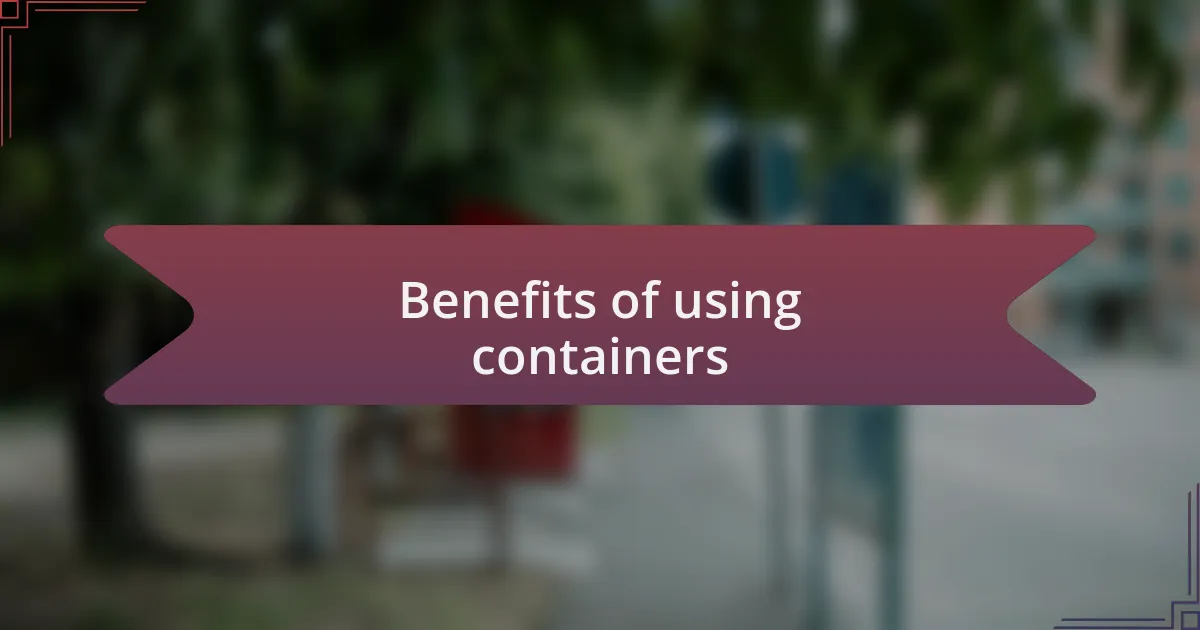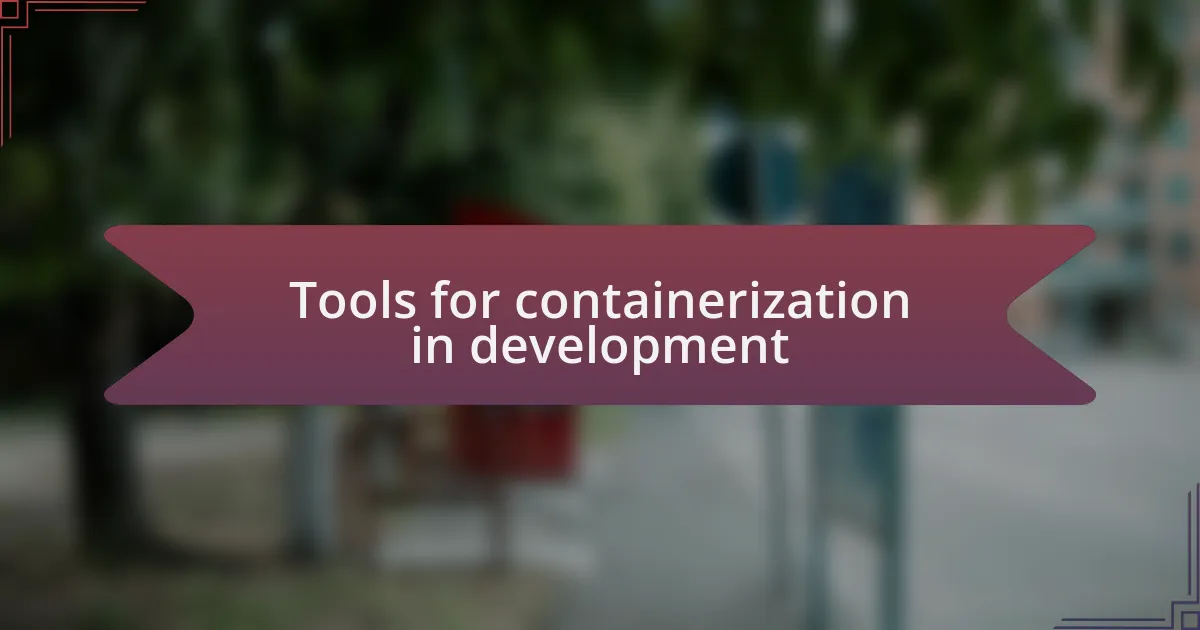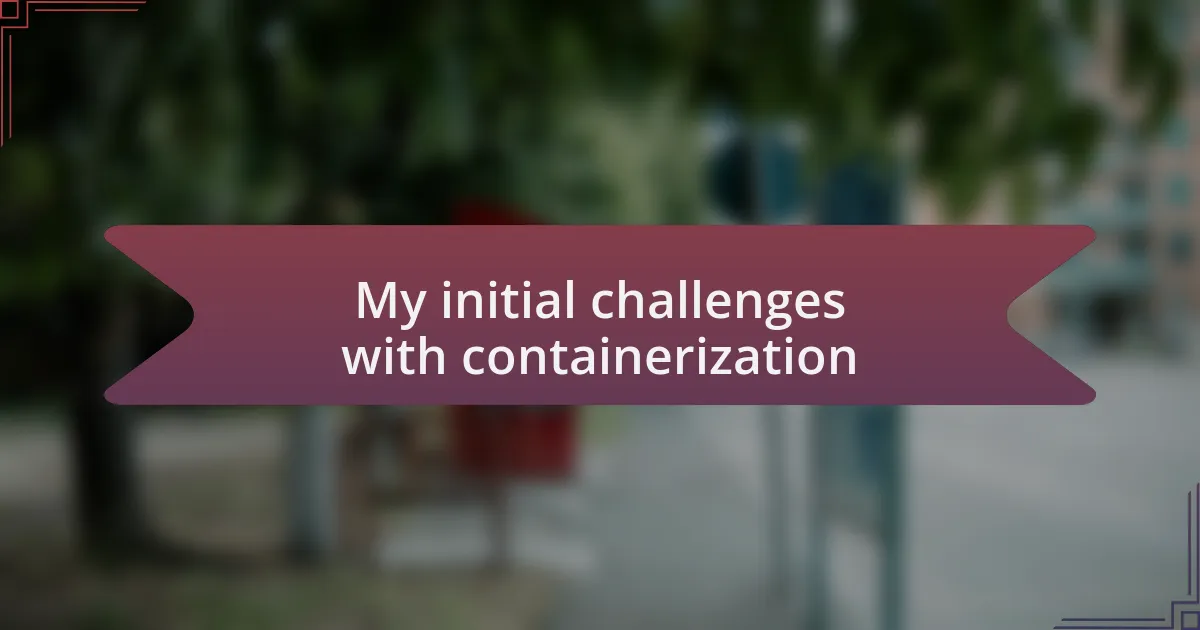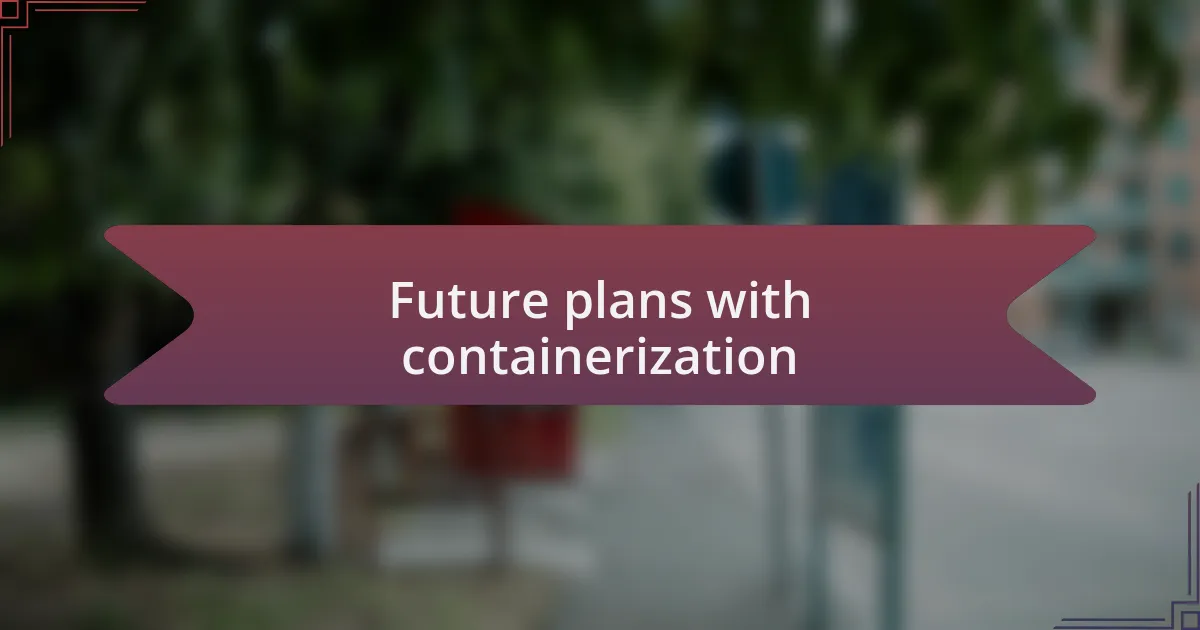Key takeaways:
- Containerization enhances consistency across environments, simplifying development and reducing configuration issues for developers.
- Utilizing tools like Docker and Kubernetes can automate processes, improve resource efficiency, and foster an agile development mindset.
- Community engagement and incremental implementation are essential for successfully transitioning to containerization.
- Continuous learning and understanding the specific environment are crucial for optimizing performance and overcoming challenges in containerized applications.

Understanding containerization in software
Containerization is a method of packaging software code and all its dependencies into a single unit, known as a container. This means that whatever environment your application runs in—whether it’s a developer’s laptop or a cloud server—it behaves consistently. I remember the first time I deployed a containerized application. It was exhilarating to see it work smoothly without the usual “it works on my machine” frustrations.
When I first learned about containerization, I was surprised by how it simplified the development process. It dawned on me that containers provide an isolated environment, which means that bugs can be tackled independently of the local setup. Isn’t it reassuring to think about how developers can focus on writing code instead of wrestling with configuration issues?
Furthermore, containerization encourages collaboration and scalability. During team projects, I noticed that sharing and deploying code became seamless. Each member could work in their own container without stepping on each other’s toes. It raises an interesting question: wouldn’t you prefer to invest your time in innovation rather than troubleshooting compatibility problems? That’s the magic of containers; they create an ecosystem where creativity can thrive.

Benefits of using containers
Containers offer remarkable portability, allowing applications to run seamlessly across various environments. I still remember when I moved a project from my local machine to a cloud provider. The transition was smooth, and it felt like a breath of fresh air to have everything work right away. Can you imagine the time saved when there’s no need for extensive troubleshooting after deployment?
Another significant benefit is resource efficiency. By utilizing containers, I’ve been able to maximize system resources. I could run multiple applications on a single instance without significant performance hits. Isn’t it incredible how that allows both cost savings and faster deployment cycles?
Moreover, containers foster an agile development mindset. I experienced a shift in my team’s workflow when we adopted container orchestration tools like Kubernetes. The ability to automate deployment and scaling meant we could focus on enhancing features rather than getting bogged down by maintenance. This sense of progress and innovation was truly invigorating—doesn’t that kind of energy make every developer excited about what comes next?

Tools for containerization in development
When exploring tools for containerization in development, Docker stands out as a foundational choice. My first encounter with Docker was a revelation; it felt as if a light bulb flickered on. The ability to create containers with just a few commands was empowering, making me wonder how I ever managed development without it. Have you experienced that moment when everything clicks into place?
Kubernetes took my container experience to another level. I remember a particularly hectic deployment week when scaling our application felt like a Herculean task. With Kubernetes, I could manage multiple containers seamlessly, and the auto-scaling feature felt like having a safety net. I often pondered how many sleepless nights I could have avoided if I had known about this tool sooner.
Another tool worth mentioning is Docker Compose, which brings a new level of simplicity when managing multi-container applications. I once juggled several services that needed to communicate, and using Docker Compose allowed me to define them in a single file. It’s fascinating how such organization not only saved time but also reduced the complexity. Have you ever felt joy in untangling a mess? That’s precisely the feeling I had when everything fell into place, and the application started running as intended.

My initial challenges with containerization
Getting started with containerization was not without its hurdles. I vividly recall the first time I attempted to set up a Docker container. It felt like trying to solve a complex puzzle with half the pieces missing. I fumbled through command-line syntax and configuration files, wondering why something that promised efficiency was proving to be so daunting. Have you ever faced a technology that seemed promising but left you scratching your head? That was my introduction to containerization.
Networking posed another significant challenge for me in the beginning. Integrating containers to communicate with each other felt like teaching a foreign language. I remember being frustrated for hours, trying to get two containers to talk, only to discover I had overlooked a simple networking configuration. There’s a peculiar mix of excitement and irritation when you realize the solution was right under your nose. Has that happened to you? Moments like those teach you that attention to detail is crucial, especially when it comes to container orchestration.
Lastly, I found debugging containerized applications to be quite the adventure. The isolation of containers is a double-edged sword; while it improves consistency, it also complicates troubleshooting. I was faced with cryptic error messages that seemed to taunt me. It took quite a bit of trial and error, alongside plenty of online forums, to navigate through it all. Have you ever felt overwhelmed by the sheer volume of information while debugging? It’s a rite of passage that ultimately deepened my understanding, even if it was a bumpy road to travel.

Strategies for smooth transition
One strategy that proved invaluable during my transition was starting small. Instead of diving headfirst into moving all my applications to containers, I chose to containerize a less critical service first. This approach allowed me to experiment without the risk of major disruptions. Have you ever felt the anxiety of a large-scale change? Breaking it down into manageable pieces can ease that pressure significantly.
Another tactic I found helpful was investing time in understanding orchestration tools like Kubernetes. Initially, I viewed these tools with skepticism, overwhelmed by their features. However, after spending some time on hands-on tutorials, I began to appreciate how they could automate various processes. It was like stepping into a world of convenience! Have you ever hesitated to embrace a tool that ultimately made your life easier? That realization was a turning point for me.
Lastly, engaging with the community was crucial in my transition. I reached out to peers and participated in online forums where I could share experiences and learn from others. Each discussion brought me fresh perspectives and often sparked ideas to overcome my challenges. Have you ever realized how impactful teamwork can be? Those connections can provide the support you didn’t realize you needed.

Lessons learned during the transition
One major lesson I learned during my transition was the importance of knowing your environment. I vividly remember a moment when I hastily set up a container without fully grasping the underlying infrastructure. The resulting incompatibility issues were a rude awakening. Have you ever jumped into something only to realize you’ve missed a crucial detail? It’s a humbling reminder that context matters; understanding your system’s unique requirements can save a lot of headaches down the line.
Another insight revolved around resource management. Early on, I underestimated how containers might affect resource allocation. I had a few late nights when my applications were competing fiercely for CPU and memory. This made me realize the critical role of monitoring tools in optimizing performance. Have you ever wondered how something seemingly small can hold back your entire project? That revelation kept me experimenting, adjusting, and ultimately improving my applications’ efficiency.
Lastly, I found that continuous learning is pivotal in the containerization journey. There were moments of doubt, especially when things didn’t go as planned. I remember feeling frustrated when an update broke my deployment. However, each setback was an opportunity to grow. Have you experienced a challenge that turned out to be a lesson in disguise? Embracing failures helped me see the bigger picture and reinforced the idea that persistence often leads to success.

Future plans with containerization
When I think about my future plans with containerization, one key aspect is scaling my applications more effectively. I once faced a situation where unexpected traffic caused my services to crash, leaving users frustrated. That experience taught me how container orchestration tools, like Kubernetes, could manage scaling automatically. Have you thought about how vital it is to keep your applications up and running, even during peak usage?
Moreover, I’m excited about integrating more microservices into my architecture. I previously held onto a monolithic design, which, while comfortable, limited my flexibility. After experiencing the agility that containerization offers, I now see the potential for creating services that can be updated independently. Isn’t it liberating to consider that breaking down a complex system into manageable services can lead to greater innovation?
Lastly, there’s an incredible opportunity to leverage serverless architectures alongside containerization. I remember discovering how functions as a service could work harmoniously with my containers during an online workshop. This combination not only optimizes costs but also increases efficiency. Have you explored how the synergy between these approaches could transform your development process? It’s a thrilling prospect that has me thinking about endless possibilities for the projects ahead.